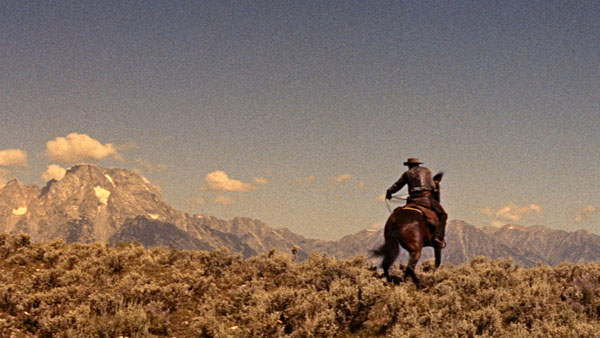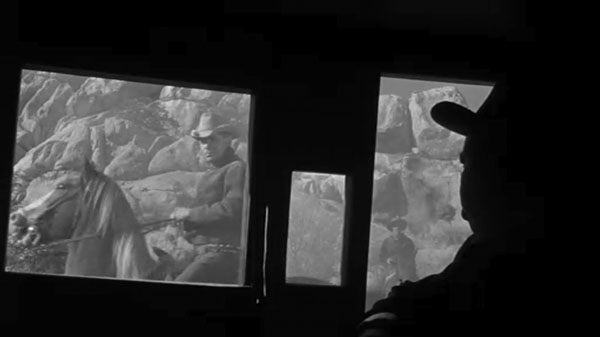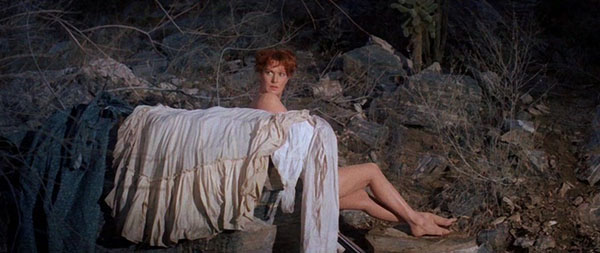“Delmer Daves is having a moment,” begins R. Emmet Sweeney at Movie Morlocks. “The Criterion Collection, the closest thing the U.S. has to a cultural gatekeeper, just released 3:10 to Yuma (1957) and Jubal (1956) on DVD and Blu-Ray, while the Anthology Film Archives in New York City is holding a mini-retrospective [through Thursday] of rarely screened Daves titles, including Pride of the Marines (1945) and The Red House (1947). I had never delved into the director’s work because the ambivalent words of Andrew Sarris and Manny Farber were ringing in my head. Sarris thought his films had ‘stylistic conviction in an intellectual vacuum,’ while Farber positioned Daves against the Spartan ‘Hawks-Wellman tradition’ as ‘a Boys Life nature lover who intelligently half-prettifies adolescents and backwoods primitives.’ While encapsulating their writing approaches, Sarris’s lucidity versus Farber’s contradictory collisions, they both convey images of shallow postcard beauty. Then I saw Daves’s extraordinary The Hanging Tree (1959, on DVD from the Warner Archive), which uses a cliffside cabin as a visual metaphor for Gary Cooper’s moral atrophy, and realized his use of landscape is far more complex than Boys Life kitsch. Eager for more, I watched five Daves films over the weekend, which revealed a sensitive director of actors drawn to tales of regeneration both spiritual and physical.” What follows are his takes on Pride of the Marines, The Red House, Broken Arrow (1950), Jubal, and Cowboy (1958).
Writing for Criterion, Kent Jones begins by emphasizing that Daves was a westerner, “born in San Francisco at the turn of the 20th century.”
He was one of the most visually gifted directors in all of American cinema (he had training as a graphic artist), and he had a strong documentary bent that gives a special flavor to all of his films, setting his westerns, in particular, apart from those of his peers. To watch those westerns in the order of the time periods they cover is to come away with a rich sense of the evolution of the West, the look of the towns and the houses, the hotels and the bars, the way of living, the loneliness. The most striking element of Daves’s filmmaking, however—and perhaps the principal reason for his current lack of renown—may be his steadfast dedication and moving attunement to the very best in people. In his cinema, there is no pure malignance, only misguided jealousy, ambition, and envy. Resignation, cynicism, and paranoia—among the most common characteristics of postwar American movies—are almost entirely absent. In certain cases, this results in a dramatic quandary: some of his malefactors and villains are not much more than the human equivalents of railroad switches, so little feeling does he have for malice. But there’s a trade-off. Daves is an absolute rarity in cinema, an artist of the good. All of these qualities resonate throughout his films. In 1956’s Jubal, as in all of his finest work, they converge and harmonize into a sustained chord of affirmation.
And in another essay, this one on 3:10 to Yuma, Jones writes: “Unlike, say, Howard Hawks or Nicholas Ray or Anthony Mann, directors whose careers afford rough parallels to that of Daves, he was not reclaimed by auteurism… In fact, Daves could be counted as one of its casualties…. A comparison between Daves and Hawks is particularly illuminating. Daves was a filmmaker of grand rhetorical gestures; Hawks was not. Daves was passionately interested in landscape and history, Hawks in neither. Daves was a fundamentally openhearted artist of the natural world; Hawks’s sensibility was sleek, sophisticated, and urban, whatever the setting…. In auteurist lore, 3:10 to Yuma has always come out on the losing end of this comparison—Rio Bravo is bravely, idiosyncratically ‘pragmatic,’ while the Daves film is merely, and fashionably, ‘psychological.’ But that is to understand the matter only as Hawks did.” 3:10 to Yuma “is, as Bertrand Tavernier has written, a ‘magnificent parable of liberty’—as well as a moving depiction of a marriage at a crossroads, a fascinating study in ambiguity, and one of the most visually striking of all westerns. On many levels, 3:10 to Yuma stands alone in the genre and, I think, in American cinema.”
“He’s not one of my guys, but those who love Sam Peckinpah love him very very much, and for those folks there is good news this week in the form of editions of two of his early films,” writes Dave Kehr at his place. As you can imagine, with that, he’s sparked quite a discussion—civil and informative, as always, but still. At any rate, the films are Peckinpah’s first feature, The Deadly Companions (1961) and Major Dundee (1965).
Kehr in the New York Times on the former: “Although he’s working with a star (Ms. O’Hara) and a cinematographer (William H. Clothier) associated with John Ford, Peckinpah already seems determined to dissociate himself from Ford’s West: his frontier community is not an early bloom of civilization but rather a center of cruelty and hypocrisy; the Apaches the travelers will encounter on route are not Ford’s noble warriors but savages, pure and simple; the characters are driven not by the pioneer spirit but by vengefulness, bitterness and base profit. Though there had been anti-westerns before (notably Robert Aldrich’s caustic Vera Cruz of 1954), The Deadly Companions leaves no doubt that a corner has been turned.”
And on Major Dundee: “Based on a treatment by Harry Julian Fink (Dirty Harry), the film seems a direct reaction to Ford’s Fort Apache (1948), with Charlton Heston cast as a more psychotic, more bluntly careerist version of Ford’s Lt. Col. Owen Thursday (Henry Fonda). Both characters are disgraced Civil War officers who hope to regain the respect of their superiors by leading an ill-advised campaign against a tribal insurrection. Peckinpah plays Heston’s square-jawed intransigence against the aristocratic refinement of a Southern officer (overplayed by Richard Harris), suggesting that Heston’s character represents the encroachment of shallow, 20th-century commercial values on the heroic individualism of the 19th century—a theme that Peckinpah would soon make his own.”
“The general line on Major Dundee is that it is a dry-run movie, a warm up for The Wild Bunch, as Pershing’s expedition after Pancho Villa was the dress rehearsal for World War I,” writes Nick Pinkerton at Sundance Now. But he’d clearly agree with Joseph Jon Lanthier, who argues in Slant that Dundee is anything but minor Peckinpah.
Meantime, Peter Bogdanovich‘s recently revisited three slices of Americana, John Ford’s Judge Priest (1934) and Drums Along the Mohawk (1939), and King Vidor (and David O. Selznick‘s) Duel in the Sun (1946).
Update, 5/16: Sean Axmaker at MSN on Jubal: “It’s been called Othello on the range, with Rod Steiger as the bitter ranch hand playing Iago to Borgnine’s Othello, but the Desdemona of this piece is no innocent victim but a dark, exotic beauty (she’s Canadian, apparently to explain away Valerie French’s accent) in a stifling marriage to the sincere but crude and boisterous cattleman. Young and deeply disenchanted, she sets her eyes on the simple, stoic cowboy. This is less a Shakespeare western than a Hollywood melodrama in chaps and Daves was a seasoned hand at both genres.” And 3:10 to Yuma: “The story is pure Elmore Leonard, both deflating and celebrating against-all-odds heroism in a well-plotted waiting game.”
Update, 5/20: Criterion‘s posted a collection of Daves’s drawings.
Update, 6/1: “I agree entirely with Jones that 3:10 to Yuma (ignoring its reportedly lamentable recent remake) is a remarkable achievement,” writes Jonathan Rosenbaum. “I’m less certain about the virtues of Jubal.”
For news and tips throughout the day every day, follow @KeyframeDaily on Twitter and/or the RSS feed. Get Keyframe Daily in your inbox by signing in at fandor.com/daily.






